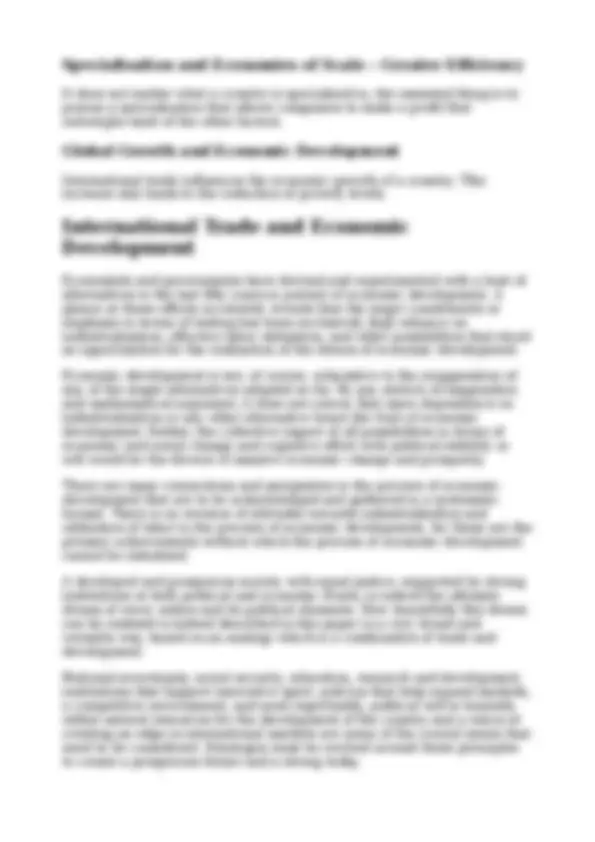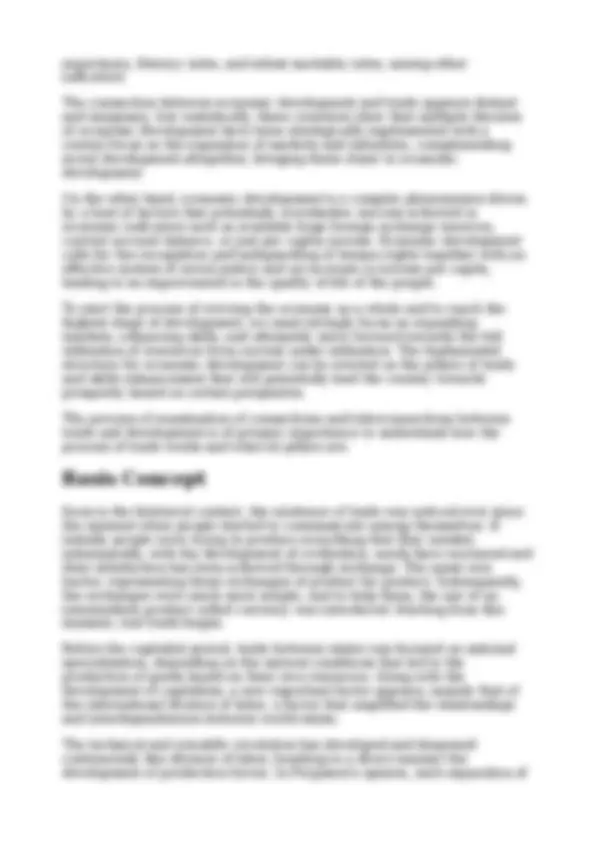





Study with the several resources on Docsity

Earn points by helping other students or get them with a premium plan


Prepare for your exams
Study with the several resources on Docsity

Earn points to download
Earn points by helping other students or get them with a premium plan
Community
Ask the community for help and clear up your study doubts
Discover the best universities in your country according to Docsity users
Free resources
Download our free guides on studying techniques, anxiety management strategies, and thesis advice from Docsity tutors
The intricate relationship between internal and international trade and their impact on economic development. It delves into the concepts of internal trade, including wholesale and retail trade, and examines the role of chambers of commerce in promoting domestic trade. The document then explores international trade, highlighting its growth, reasons, and importance in fostering global economic prosperity. It further analyzes the connection between trade and economic development, emphasizing the role of industrialization, labor utilization, and market expansion in achieving sustainable growth. The document concludes by examining the historical context of trade and its evolution, highlighting the significance of international specialization and the emergence of a global market.
Typology: Lecture notes
1 / 6

This page cannot be seen from the preview
Don't miss anything!




Internal trade, also known as domestic trade, refers to the buying and selling of goods and services within the confines of a nation's international boundaries. While import and export activities are important for a country's economy, the majority of its GDP contribution comes from internal trade.
Internal trade can be further divided into wholesale trade and retail trade. Wholesale trade involves the sale of goods in bulk to retailers, who then sell them to consumers. Retail trade, on the other hand, involves the sale of goods directly to consumers.
There are several types of retailing trade, including:
Fixed Shop - Large Retailers and Chain Stores or Multiple Shops : These are large retail establishments, often part of a chain, that operate from fixed locations.
Mail Order Houses, Consumer Cooperative Stores, and Supermarkets : These are alternative retail formats that cater to consumers' needs.
The Indian Chambers of Commerce and Industry play a significant role in promoting and supporting internal trade within the country.
International trade refers to the exchange or trade of goods and services between different nations. This type of trade contributes to and increases the global economy.
The most commonly traded commodities in international trade include television sets, clothes, machinery, capital goods, food, and raw materials.
International trade has seen exceptional growth, including the trade of services such as foreign transportation, travel and tourism, banking, warehousing, communication, distribution, and advertising. Additionally, there has been an increase in foreign investments and the production of foreign goods and services in international countries.
Production : Not every country can produce all goods and services at an equally low cost, necessitating international trade.
Factors of Production : The availability and cost of factors of production, such as labor, capital, and raw materials, vary across countries.
Cost of Production : Countries find it advantageous to specialize in and produce only those goods and services that they can efficiently produce, while outsourcing the rest to other countries at a lower cost.
Resource Distribution : The unequal distribution of natural resources across countries can lead to the need for international trade.
Examples : Different regions or states within a country may specialize in certain sectors, such as textiles in Maharashtra, jute products in West Bengal, food products in Haryana and Punjab, and spices in Kerala.
The Importance of International Trade
International trade between various nations is an essential factor that is responsible for the increase in the standard of living, creating employment, and empowering consumers to enjoy different kinds of goods. Some other important factors that are influenced by international trade include:
Some countries are naturally blessed with an abundance of raw materials, like Qatar is for oil and Iceland for metals and fish. Without international trade, these countries would never benefit from their natural resources or raw materials.
More international trade results in more choices of products for consumers.
Pathways to economic development and change are numerous and vivid, but the intention of this paper is to elaborate in a broad fashion the prospective possibilities that exist for the reformation of trade and economic development and how international trade can bring magnificent changes in the process of economic development.
Normally, trade or exclusive dependence on trade for the subjective purpose of attainment of a certain rate of growth in GNP calls for a wide variety of economic, political, and social complementarities. Indeed, the view that trade can become a factor of relief in or for economic development is not an easy belief.
Over the last 3 decades, Asian economies like China, Korea, Taiwan, and Singapore have registered significant growth rates in terms of GNP per capita income, advancement in the level of technology, and a rise in the standard of living, mainly because the share of trade in the composition of GNP has been dominant and driven by other socio-economic changes.
The basic philosophy of the Park Chung Hee government in Korea was "exports first" or "nation building through export promotion". China's international trade has experienced rapid expansion together with its dramatic economic growth, which has made the country target the world as its market. The stable political system, vast natural resources, and abundant skilled labor in China have made it a modern global factory.
The growth story in China is formidably a product of three vital elements that cannot be ignored while making assumptions and policy prescriptions for the advancement of economic growth and development. Firstly, the stable political system turned into a rock-solid foundation for structuring economic policies focusing on effective resource utilization and helped China grow its economic activities that ultimately placed it closer to the path of economic development. Secondly, the uniqueness of Chinese growth lies in the expansion of its market base that crossed its borders and eventually became a dominant export-based economy in the world. This is the result of accessing markets overseas, where China maneuvered quite wonderfully. Capitalization on comparative advantage or the development of comparative advantage by effectively and sensibly utilizing resources in these years have demonstrated economic advancement in China.
The emergence of Taiwan's SMEs is closely related to the economic, social, and educational policies adopted by the government in the past. The 'Land to the Tiller' program, the Economic Construction Plan, the implementation of compulsory education in 1968, and the Ten Major Construction Projects plan, along with other measures adopted in the areas of economic development, manpower resources, social stability, and public construction, have all provided SMEs with an excellent environment in which to grow and develop.
The Taiwanese experience so far exclusively reveals that a combination of both nation-building plans, like huge investments in infrastructure, technology, education, and export promotion policies, has led to rapid industrialization as well as development measured in terms of life
expectancy, literacy rates, and infant mortality rates, among other indicators.
The connection between economic development and trade appears distant and imaginary, but realistically, these countries show that multiple theories of economic development have been strategically implemented with a central focus on the expansion of markets and industries, complementing social development altogether, bringing them closer to economic development.
On the other hand, economic development is a complex phenomenon driven by a host of factors that potentially overshadow success achieved in economic indicators such as available huge foreign exchange reserves, current account balance, or just per capita income. Economic development calls for the recognition and safeguarding of human rights together with an effective system of social justice and an increase in income per capita, leading to an improvement in the quality of life of the people.
To start the process of reviving the economy as a whole and to reach the highest stage of development, we must strongly focus on expanding markets, enhancing skills, and ultimately move forward towards the full utilization of resources from current under-utilization. The fundamental structure for economic development can be erected on the pillars of trade and skills enhancement that will potentially lead the country towards prosperity based on certain perquisites.
The process of examination of connections and interconnections between trade and development is of primary importance to understand how the process of trade works and what its pillars are.
Basis Concept
Seen in the historical context, the existence of trade was noticed ever since the moment when people started to communicate among themselves. If initially people were trying to produce everything that they needed, subsequently, with the development of civilization, needs have increased and their satisfaction has been achieved through exchange. The name was barter, representing those exchanges of product for product. Subsequently, the exchanges were much more simple, and to help them, the use of an intermediate product called currency was introduced. Starting from this moment, real trade began.
Before the capitalist period, trade between states was focused on national specialization, depending on the natural conditions that led to the production of goods based on their own resources. Along with the development of capitalism, a new important factor appears, namely that of the international division of labor, a factor that amplified the relationships and interdependencies between world states.
The technical and scientific revolution has developed and deepened continuously this division of labor, boosting in a direct manner the development of production forces. In Ferguson's opinion, such separation of